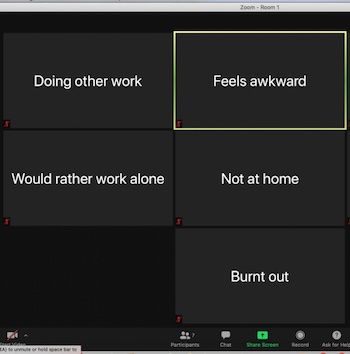
Before the pandemic, way back In November 2019, a group of academic meeting researchers from several universities, business leaders, and consultants met to review and analyze hundreds of research studies about what makes meetings effective. They published “Ten Rules Simple Rules for Meaningful Meetings.” One of the science-based findings identified that online meetings get the same results as in-person meetings when everyone turns on their video cameras.
Now that we have close to two-years of zoom meetings under our belts, we are discovering that people are exhausted from video conference meetings – and engagement (and productivity) may be plumeeting. And it may have implications for our health.
“In person, we are able to use our peripheral vision to glance out the window or look at others in the room. On a video call, because we are all sitting in different homes, if we turn to look out the window, we worry it might seem like we’re not paying attention,” writes Liz Fosselien for Harvard Business Review. “Not to mention, most of us are also staring at a small window of ourselves, making us hyper-aware of every wrinkle, expression, and how it might be interpreted. Without the visual breaks we need to refocus, our brains grow fatigued.”
It has been dubbed “Zoom Fatigue,” or feeling drained after a day in front of the camera, is becoming a part of our daily work lives. Jeremey Bailenson, director of Stanford University’s Virtual Human Interaction Lab has been studying this malady suggests that it is caused by Nonverbal Overload. Looking at the Zoom grid of people’s heads elicits the flight or fight response (activation of the sympathetic nervous system that triggers an acute stress response that prepares the body to fight or flee). Zoom fatigue is not healthy to have stress hormones pumping into our system for hours a day and can lead to burnout and other health issues.
The researchers have come up with a Zoom Fatigue scale so you can measure how exhausted you are after meetings. You can find the free assessment here.
The researchers at Stanford have offered up some simple fixes for reducing zoom fatigue.
- Don’t use Zoom full-screen option and reduce the size of the Zoom window relative to the monitor to minimize face size, and use an external keyboard to allow an increase in the personal space bubble between oneself and the grid.
- Use the “hide self-view” button so you are not forced to stare at yourself. The feature be accessed by right-clicking your profile on the screen after you have framed yourself properly.
- Adjust your camera farther away from the screen and that will allow you to pace and doodle in virtual meetings just like we do in real ones. And of course, turning one’s video off periodically during meetings is a good ground rule to set for groups, just to give oneself a brief nonverbal rest.
- If you can’t avoid long stretches of meetings, give yourself an “audio only” break. Not only turn your camera off, but turn away from the screen to reduce the cognitive load.
Adam Grant recently shared some research that suggests we should create a meeting norm that encourages us to keep our cameras-off to fight zoom fatigue. Cameras-off does not reflect disengagement, but helps improve attention and prevents burnout.
There are a few more benefits to turning off your camera on Zoom. It helps reduce appearance anxiety – both in terms of pretending to be engaged and how your face looks, having a perfect home office decor, or your cats or family members making a cameo appearance on the screen.
Turning off your camera can also reduce the carbon footprint of online meetings by up to 96%. Platforms like zoom demand a significant amount of processing power, which uses more electricity and other forms of energy. If one hour of videoconferencing emits 150–1000 grams of carbon dioxide and requires up to 12 liters of water, imagine the environmental benefit if everyone had their cameras off during back-to-back zoom meetings.
So how does your team make it okay to keep your camera off during meetings? One way is to establish meeting norms or standards of behavior or rules of engagement for meetings. What that means in practice is that norms are the ground rules for how a group of people communicate and collaborate with each other. By explicitly stating norms, every member of the meeting will understand how to act (and interact) with others. They also provide a standard against which members can give each other feedback.
You can co-create meeting norms with your team or organization by facilitating a discussion about the types of communication or collaboration behaviors that make for an effective meeting or collaboration. Having a discussion about the rules around camera on or off during zoom meetings is something to discuss and agree on. (Here’s more on co-creating meeting norms for your nonprofit’s meetings)
Why not try an experiment with your nonprofit team and turn the cameras off for meetings – and see how it impacts engagement, attention, and exhaustion. It may become your new norm.
Does your team have a “cameras-on” or “camera-off” norm for virtual meetings? Why?

Leave a Reply